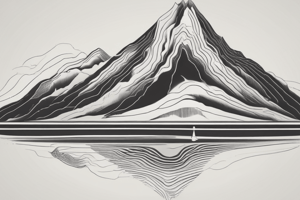Podcast
Questions and Answers
According to Csikszentmihalyi's research, flow is achieved when an individual experiences a balance between:
According to Csikszentmihalyi's research, flow is achieved when an individual experiences a balance between:
- Boredom and apathy.
- Skills that are appropriately matched to the challenge at hand. (correct)
- External rewards and intrinsic motivation.
- High levels of anxiety and relaxation.
Active leisure, a context in which flow frequently appears, is best described as:
Active leisure, a context in which flow frequently appears, is best described as:
- Skill-based hobbies that provide challenges and require the use of skills. (correct)
- Passive recreational activities, such as watching television.
- Routine chores that engage the body without requiring any skills.
- Relaxing activities with minimal mental or physical exertion.
Which statement accurately reflects the relationship between intrinsic motivation and flow?
Which statement accurately reflects the relationship between intrinsic motivation and flow?
- Intrinsic motivation decreases the likelihood of achieving flow because it distracts from performance goals.
- Intrinsic motivation fuels flow by encouraging engagement in activities for their inherent satisfaction, creating a positive feedback loop. (correct)
- Extrinsic rewards are necessary to maintain the deep engagement experienced in flow.
- Flow is only possible when clear external goals are defined.
Which of the following is NOT a condition that fosters the experience of flow?
Which of the following is NOT a condition that fosters the experience of flow?
Which of the following is a key characteristic of the flow state?
Which of the following is a key characteristic of the flow state?
According to Gilbert's research on synthesizing happiness, individuals:
According to Gilbert's research on synthesizing happiness, individuals:
Which of the following theories of humor suggests that laughter arises from feelings of increased self-esteem through putting others down?
Which of the following theories of humor suggests that laughter arises from feelings of increased self-esteem through putting others down?
In what way does humor contribute to well-being in healthcare settings?
In what way does humor contribute to well-being in healthcare settings?
What practical step is recommended to cultivate flow by structuring one's external environment?
What practical step is recommended to cultivate flow by structuring one's external environment?
If someone finds tasks too easy and becomes bored, how can they regain a state of flow?
If someone finds tasks too easy and becomes bored, how can they regain a state of flow?
According to the concept of micro-resilience, refocusing the brain involves:
According to the concept of micro-resilience, refocusing the brain involves:
What role does sleep play in the context of learning and creativity?
What role does sleep play in the context of learning and creativity?
In the context of micro-resilience, what does resetting the primitive alarm refer to?
In the context of micro-resilience, what does resetting the primitive alarm refer to?
What is the primary focus of Michael Ungar's Multisystemic Resilience framework?
What is the primary focus of Michael Ungar's Multisystemic Resilience framework?
Which of the following is NOT one of the dimensions of resilience in Ungar's Multisystemic Resilience framework?
Which of the following is NOT one of the dimensions of resilience in Ungar's Multisystemic Resilience framework?
What is the purpose of the Reivich & Shatte exercise in the context of resilience?
What is the purpose of the Reivich & Shatte exercise in the context of resilience?
What does Taleb's concept of 'antifragility' suggest?
What does Taleb's concept of 'antifragility' suggest?
According to Shahar's SPIRE model, what does the 'R' stand for?
According to Shahar's SPIRE model, what does the 'R' stand for?
Tedeschi and Calhoun define Post-Traumatic Growth (PTG) as:
Tedeschi and Calhoun define Post-Traumatic Growth (PTG) as:
Which PTG area identified by Tedeschi & Calhoun involves a deeper understanding of life's value?
Which PTG area identified by Tedeschi & Calhoun involves a deeper understanding of life's value?
Within the model of crisis leading to PTG, what role do personal and external factors play?
Within the model of crisis leading to PTG, what role do personal and external factors play?
What is the main goal of the PATHH program developed by the Boulder Crest Foundation?
What is the main goal of the PATHH program developed by the Boulder Crest Foundation?
What does Dr. Peter Levine suggest about the nervous system in the context of inner-resourcing?
What does Dr. Peter Levine suggest about the nervous system in the context of inner-resourcing?
Which of the following activities is suggested as a method to facilitate pendulation of the nervous system?
Which of the following activities is suggested as a method to facilitate pendulation of the nervous system?
What is the main purpose of pendulation activities in inner-resourcing?
What is the main purpose of pendulation activities in inner-resourcing?
Flashcards
Flow State
Flow State
A state of optimal performance where skills match the challenge, leading to deep engagement and enjoyment.
Active Leisure
Active Leisure
Activities that require skill and present a challenge, leading to flow, enjoyment, and skill development.
Conditions of Flow
Conditions of Flow
Clear and attainable goals, skills meeting the challenge, constraints like rules, timely feedback, and personal control.
Impacts of Flow
Impacts of Flow
Signup and view all the flashcards
Intrinsic Motivation Loop
Intrinsic Motivation Loop
Signup and view all the flashcards
Hedonic Happiness
Hedonic Happiness
Signup and view all the flashcards
Eudaimonic Happiness
Eudaimonic Happiness
Signup and view all the flashcards
Synthesizing Happiness
Synthesizing Happiness
Signup and view all the flashcards
Relief Theory of Humor
Relief Theory of Humor
Signup and view all the flashcards
Superiority Theory of Humor
Superiority Theory of Humor
Signup and view all the flashcards
Incongruity Theory of Humor
Incongruity Theory of Humor
Signup and view all the flashcards
Effective Pathway to Flow
Effective Pathway to Flow
Signup and view all the flashcards
Micro-Resilience
Micro-Resilience
Signup and view all the flashcards
Affective Forecasting Bias
Affective Forecasting Bias
Signup and view all the flashcards
Preserve Self-Esteem Bias
Preserve Self-Esteem Bias
Signup and view all the flashcards
Primitive Alarm Response
Primitive Alarm Response
Signup and view all the flashcards
Focus Brain Strategies
Focus Brain Strategies
Signup and view all the flashcards
Joy Kits
Joy Kits
Signup and view all the flashcards
Multisystemic Resilience
Multisystemic Resilience
Signup and view all the flashcards
12 Dimensions of Resilience
12 Dimensions of Resilience
Signup and view all the flashcards
Components of Resilience
Components of Resilience
Signup and view all the flashcards
Reivich & Shatte Exercise
Reivich & Shatte Exercise
Signup and view all the flashcards
Post Traumatic Growth
Post Traumatic Growth
Signup and view all the flashcards
SPIRE
SPIRE
Signup and view all the flashcards
Ways to Lift Spirit
Ways to Lift Spirit
Signup and view all the flashcards
Study Notes
- Flow: Optimal Performance
- Flow is the state of optimal performance, a midpoint between boredom and apathy, where skills adequately match the challenge.
- Flow is frequently experienced during work and active leisure.
- Active leisure involves skill-based hobbies, demanding skills and offering challenges.
Benefits of Flow
- Improved emotional regulation
- Greater enjoyment and fulfillment
- Increased happiness
- Greater intrinsic motivation
- Increased engagement
- Enhanced learning and skill development
- More creativity from engaging in an activity.
Conditions of Flow
- Clear and attainable goals
- Skills meeting the challenge
- Constraints like rules or deadlines
- Timely feedback
- Personal control.
Impacts of Flow
- Intense concentration
- Diminished self-consciousness
- Lack of awareness of physical needs
- Distorted sense of time
- Doing personal best
- Deep fulfillment.
Intrinsic Motivation
- Intrinsic motivation (doing something for its own sake) creates a positive feedback loop, enhancing performance and experiences.
- Joy
- Hedonic happiness is momentary and fleeting.
- Eudaimonic happiness arises from pursuing deep-rooted, value-based goals, providing purpose and meaning.
- People synthesize happiness by reframing circumstances, even negative ones, through storytelling.
- The psychological immune system fosters joy and resilience after adversity.
Theories of Humour
- Relief theory: laughter relieves tension
- Superiority theory: self-esteem increases by putting down others
- Incongruity theory: surprise from unexpected punchlines.
Benefits of Humour
- Improves ability to cope with medical problems for both patients and healthcare givers.
- Enhances coping with mental illness.
- Enhances relationships on the job.
- Increases life satisfaction and engagement.
- Aids language learning by fostering engagement.
- Associated with higher immune function in cancer patients.
- Is within the top eight character strengths linked to well-being.
-
Recap
- To achieve flow, organize the external environment by engaging in clear, goal-directed, rule-bound activities and making the activity meaningful.
- It's important to attend to feedback, ignore distractions, focus on the task, and take creative control.
- Regain flow by adjusting the balance between challenge and skill; increase skill if the challenge is too stressful or add challenge if tasks are too boring.
- Cultivating joy relies on how experiences are framed, while synthesizing joy can yield as much happiness as achieving desired outcomes.
- A large part of happiness stems from how we remember and narrate events.
-
Two Models of Resilience: Micro-resilience & Multisystemic Resilience
Micro-Resilience - St. John & Haines
- The 16-second cure involves energy recovery, baseline reset, and positive focus.
Micro-Resilience Five Steps
- Refocus the brain on solutions
- Overcome procrastination by following a plan, not mood, using a 15-minute break rule, and investing in the future self.
- Reduce biases like affective forecasting, and preserve self-esteem
- Reset the primitive alarm (fight-flight-freeze-face response) with strategies like progressive muscle relaxation, music/sound, smell, posture, visualization, and breathing.
- Reset attitude using joy kits for an attitude shift.
- Refresh body with water and sleep.
- Good sleep enhances learning, memory, and creativity; deep sleep consolidates learning, while REM sleep fosters creative solutions.
- Renew spirit by intentionally applying chosen strategies.
Multisystemic Resilience - Michael Ungar (85)
- Negotiate 12 dimensions of resilience to thrive; protective factors prevent severe impacts of adversity, addressing both personal context and access to resources.
12 Dimensions of Resilience
- Structure, accountability, intimate relationships, other relationships, identity, power and control, belonging and culture, rights and responsibilities, basic needs, physical wellbeing, financial wellbeing, and positive thinking.
Michael Ungar's Pathways to Resilience Project
- A study of youth ages 13 to 19, identified 7 components needed to thrive: access to material resources, relationships, identity, power and control, cultural adherence, social justice, and cohesion.
Reivich & Shatte Exercise
- Consists of contemplating the worst-case scenario, best-case scenario, most likely outcome, and an action plan.
- Post Traumatic Growth Bouncing Forward / Resilience 2.0
- Antifragility- coined by Taleb
SPIRE - Shahar
- Explains how resilience can lead to growth after adversity
- Encompases spiritual, physical, intellectual, relational, and emotional dimensions of happiness.
- Key practices include: permission to be human, simplification, regular exercise, and a focus on the positive.
- High Intensity Interval Training involves exerting self at 90% for 1 minute, followed by rest, repeated multiple times.
Tedeschi and Calhoun - PTG
- PTG involves positive change as a result of crises - gain from loss
- PTG encompasses: an appreciation for life, personal strength, new possibilities, improved relationships, and spiritual growth.
- The model of crisis involves crisis leading to stress, then coping mechanisms, influenced by personal and external factors such as support networks.
- PATHH (Progressive and Alternative Training for Helping Heroes) offers peer support for first responders and military personnel to foster PTG and has shown a 56% increase in PTG after 18 months.
- Inner-Resourcing
- The nervous system pendulates between sympathetic and parasympathetic states.
- Pendulation activities: nostril breathing, hand clasp breath, and butterfly hug (tapping).
Studying That Suits You
Use AI to generate personalized quizzes and flashcards to suit your learning preferences.




